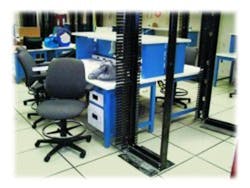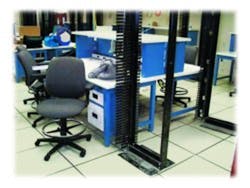Classification of the ESD control capability depends on its function as a conductor or a static dissipator. The resistance of a conductive floor is <1 × 104 W, while dissipative flooring has a resistance of 1 × 104 to 1 × 1011 W. A conductive floor is recommended when personnel in the area will be wearing static-control footwear, and a dissipative floor is optimum for areas hosting a wide variety of users.
After choosing the conductive or dissipative characteristics, use and appearance are the factors most often considered in selecting an ESD-safe floor. There is a type of ESD-control flooring for every area in a manufacturing plant, and the choice depends on the location. Where looks are important, you can find tiles and carpet in a variety of colors and patterns.
In a high-traffic warehouse or production site where you need a dense surface that is both abrasion- and impact-resistant, has high compressive and tensile strength, and can survive chemical spills, an epoxy coating may be ideal. The Garland Floor CrystalStat ESD™ Epoxy Floor Coating is one such product, available with conductive or dissipative characteristics. It comes in several colors and finishes and can be provided with decorative flakes or colored quartz aggregate. Hardness and resistance to abrasion and impact are specified by the manufacturer using the American Society for Testing and Materials (ASTM) test methods.
Vinyl tiles are a viable option for the typical electronic production area where there is foot traffic but no severe abuse. Installation and maintenance costs for this material are relatively low when compared to epoxy coating, and the flooring comes in an assortment of colors.
For example, the 3M™ Electronic Handling and Protection Division offers the 8400 Series Static Control Vinyl Floor Tile in 12 colors. The 8410 and 8420 tiles are dissipative. The static generation is <50 V with conductive footwear at 20% RH, and decay is <0.10 s. The 8430 and 8440 versions are conductive with <25-V static generation and <0.03-s decay. They come in 12², 24², and 36² squares and can be seam-welded for optimum ESD protection.The clean room isn’t likely to have heavy traffic, so the epoxy coating as well as certain types of vinyl tile are appropriate here. The selected material must not contain carbon, a source of contamination. It also can’t have volatile organic compounds or other materials that outgas.
The office or other low-traffic workplace is appropriate for carpet. In addition to ESD protection, it offers a choice of colors, comfort, and noise control.
Floor Characteristics
A set of test methods for conductive and dissipative floors was outlined by Crawford Smith, a senior development chemist at VPI Floor Products Division: “There are two test methods to measure the electrical resistance of flooring, both recommending a room temperature of 23 ±1°C.
- ASTM F-150-98, Standard Test Method for Electrical Resistance of Conductive Resilient Flooring, specifies point-to-point and point-to-ground resistance ranges for conductive and dissipative flooring at 50 ±5% RH with applied voltages of 100 V and 500 V.
- ANSI/ESD S7.1-94, Floor Materials—Resistive Characterization of Materials, requires point-to-point and point-to-ground resistance at 12% and 50% RH with 100 V applied through 5-lb conductive probes.
“The resistance-measuring equipment and electrodes for resistance test have an alternate electrode with aluminum foil as the contacting surface. The test specimen in F-150 is 48² × 48², and the surface contact points are 36² apart. The specimen in ESD 7.1 is 12² × 24², and the distance between surface contact points should be a maximum of 20². On installed floors, a minimum of five tests per 5,000 sq ft is recommended.
“The electrostatic propensity test measures the peak voltage generated when two dissimilar materials create a static charge—in this case, stepping and scuffing on the vinyl flooring in a room conditioned to 20% RH at 70°F. Various conductive and dissipative shoe sole and heel materials are used in the testing, including leather and Neolite, with and without foot and heel grounders. An electrometer with a voltage divider probe, a recorder, and an ionization source, such as a 2-ft wand containing strips of polonium 210, are required for the test.
“The static-decay test needs a desiccating chamber, a high-voltage source, an electrometer, a small clear acrylic test chamber, and a room conditioned to 73°F at 50 ±5% RH. Three sets of flooring specimens are preconditioned: one set is heated in an oven for 12 days at 160 ±5°F, the second horizontally exposed to a continuous water shower for 24 hours, and the last maintained at ambient conditions. This test of each specimen records how long it takes to induce a surface charge and measures the intensity and polarity of the charge plus the time required for complete dissipation.”
Installing a Floor
You can’t obtain the full static-control capability of flooring unless it is installed correctly. The supplier understands that installation isn’t always easy. A craftsman may be good at laying regular tiles, but if not experienced in the special techniques of ESD floor installation, you can expect problems. For this reason, floor manufacturers are ready with some detailed guidance.
For example, Garland Floor specifies that a concrete floor to be coated with epoxy should be smooth and have a minimum compressive strength of 3,000 psi at the surface. “A Garland-trained, certified contractor cleans the surface with dry, dust-free shot-blasting equipment,” according to Thomas Geriak, vice president of operations. “The process removes all contaminating substances such as dust and loose coatings from previous applications.”
For a tile floor, the supplier typically will include a set of installation and maintenance instructions in each carton. These documents include detailed procedures for materials-conditioning, preparation of the subfloor, trowel selection, mixing and spreading of adhesive, laying the tile, rolling the floor, seamless installations, and flash coving. Additional instructions tell how to moisture-test the concrete and ground the flooring.
Floor Care
The maintenance goal for an ESD- control floor is to keep the surface clean without attacking it chemically, altering its resistance, or leaving residue. “Any barrier between the floor and people or objects will inhibit the ESD control properties of the floor,” said Brett Sheldon, product manager at Stonhard. “Dirt is the primary culprit. To degrease, clean, and remove dirt and other debris from an ESD-safe floor, use a scrubbing machine daily with a detergent that doesn’t leave a residue.”
Buying any ESD product is like buying an insurance policy. You feel that you need insurance to protect yourself in case something bad happens. However, just buying the policy isn’t enough to protect you. It is necessary to pay the premium every month.
With ESD, the premiums are not paid once a month, but every day. “If you forget routine maintenance,” said David Bermani, corporate marketing coordinator at Desco Charleswater, “the best ESD products in the world will lose their effectiveness. ESD could stand for Every Single Day.”
Acknowledgements
The following companies contributed to this article:
| Desco Charleswater | 909-627-8178 |
| Garland Floor | 800-321-2395 |
| Sauereisen | 412-963-0303 |
| Stonhard | 856-779-7500 |
| 3M Electronic Handling & Protection Division | 800-814-8709 |
| VPI Floor Products Division | 920-458-4664 |
Raised Epoxy Flooring—A Case History
by Karl Sauereisen, Sauereisen
When specifying ESD flooring for the telecommunications and electronics industries, either vinyl tile or conductive rubber is the common choice. In the case of Tachion Networks of Eatontown, NJ, the possibilities expanded by considering epoxy.
Departing from the norm is a way of life at Tachion, a company born on the principle of innovation. The company started in 1996 when some developers left Lucent Technologies to pursue their vision of multimodal communications technology. The first major development was the Collapsed Central Office, a telecommunications portal capable of transmitting data in voice, fax, and digital formats.
Tachion’s knack for finding a better way was rewarded commercially when TelePacific and Gabriel Communications placed sizable orders. Soon, others in the industry followed suit. As a result of these procurements, the company needed additional production space to meet delivery commitments. A new facility outfitted with a raised flooring system that included surface panels and a support structure was acquired.
The panels in the new facility had no ESD protection. Moving into a building without ESD-safe floors was out of the question. Since Tachion was committed to the integrity of its products, the company had to find a way to upgrade the flooring to avoid potential damage to its products from uncontrolled static discharges.
The plant manager worked with the site contractor to choose the optimum flooring. After considering the alternatives, Sauereisen’s ConducTop Epoxy Floor was selected.
The floor is constructed by sealing the substrate to insulate against subsurface moisture. This is primed with a carbon-filled epoxy with the desired conductive or dissipative resistance range and finished with a patented topcoat.
A key to the consistent electrical performance is the static-control plane that resides below the outer surface. Static charges are channeled through the topcoat to the primer. In this manner, there is no potential vulnerability because the path to ground is vertically oriented through the coating system and frame.
Application of the ESD-control coating was completed by a crew familiar with spraying paints but had never installed an ESD-control floor. Sauereisen provided on-site technical consultation so the panels were arranged to allow rapid coating using airless spray equipment. The Tachion quality engineer inspected each stage of the installation, checking electrical resistance of the coatings using test methods recommended by the ESD Association.
The completed floors met Tachion expectations, including a glossy appearance that captures a showroom look. The Sauereisen flooring was installed in all assembly areas, inventory locations, and hallways—a total of 9,000 ft2—prior to start-up.
From a functional perspective, the coating system has proven to be very durable, withstanding the physical stress imposed by heavy equipment during the move-in process. Most importantly, the system maintains consistent conductivity.
With business at Tachion growing and the facility expanding, the company installed the same flooring in a new wing in October 2000. Since this involved new construction, a greater latitude of options existed regarding the raised flooring. In this case, steel panels were used that required less surface preparation. Even though they are conductive, the steel panels needed a more controlled electrical path to ground. Two coats of nonconductive sealer effectively insulated the steel so the carbon-filled coatings could perform without interference.
About the Author
C. Karl Sauereisen is a director and marketing manager of Sauereisen, responsible for ESD flooring and high-temperature cements. Sauereisen, 160 Gamma Dr., Pittsburgh, PA 15238, 412-963-0303, e-mail: [email protected].
Return to EE Home Page
Published by EE-Evaluation Engineering
All contents © 2001 Nelson Publishing Inc.
No reprint, distribution, or reuse in any medium is permitted
without the express written consent of the publisher.
February 2001

